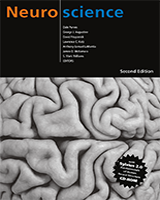From: Ion Channels Underlying Action Potentials
NCBI Bookshelf. A service of the National Library of Medicine, National Institutes of Health.
Purves D, Augustine GJ, Fitzpatrick D, et al., editors. Neuroscience. 2nd edition. Sunderland (MA): Sinauer Associates; 2001.

Neuroscience. 2nd edition.
Show detailsBox AThe Patch Clamp Method
A wealth of new information about ion channels resulted from the invention of the patch clamp method in the 1970s. This technique is based on a very simple idea. A glass pipette with a very small opening is used to make tight contact with a tiny area, or patch, of neuronal membrane. After the application of a small amount of suction to the back of the pipette, the seal between pipette and membrane becomes so tight that no ions can flow between the pipette and the membrane. Thus, all the ions that flow when a single ion channel opens must flow into the pipette. The resulting electrical current, though small, can be measured with an ultrasensitive electronic amplifier connected to the pipette. Based on the geometry involved, this arrangement usually is called the cell-attached patch clamp recording method. As with the conventional voltage clamp method, the patch clamp method allows experimental control of the membrane potential to characterize the voltage dependence of membrane currents.
Although the ability to record currents flowing through single ion channels is an important advantage of the cell-attached patch clamp method, minor technical modifications yield still other advantages. For example, if the membrane patch within the pipette is disrupted by briefly applying strong suction, the interior of the pipette becomes continuous with the cytoplasm of the cell. This arrangement allows measurements of electrical potentials and currents from the entire cell and is therefore called the whole-cell recording method. The whole-cell configuration also allows diffusional exchange between the pipette and the cytoplasm, producing a convenient way to inject substances into the interior of a “patched” cell.
Two other variants of the patch clamp method originate from the finding that once a tight seal has formed between the membrane and the glass pipette, small pieces of membrane can be pulled away from the cell without disrupting the seal; this yields a preparation that is free of the complications imposed by the rest of the cell. Simply retracting a pipette that is in the cell-attached configuration causes a small vesicle of membrane to remain attached to the pipette. By exposing the tip of the pipette to air, the vesicle opens to yield a small patch of membrane with its (former) intracellular surface exposed. This arrangement, called the inside-out patch recording configuration, allows the measurement of single-channel currents with the added benefit of making it possible to change the medium to which the intracellular surface of the membrane is exposed. Thus, the inside-out configuration is particularly valuable when studying the influence of intracellular molecules on ion channel function. Alternatively, if the pipette is retracted while it is in the whole-cell configuration, a membrane patch is produced that has its extracellular surface exposed. This arrangement, called the outside-out recording configuration, is optimal for studying how channel activity is influenced by extracellular chemical signals, such as neurotransmitters (see Chapter 7). This range of possible configurations makes the patch clamp method an unusually versatile technique for studies of ion channel function.

Four configurations in patch clamp measurements of ionic currents.
References
- Hamill O. P. , Marty A. , Neher E. , Sakmann B. , Sigworth F. J. Improved patch-clamp techniques for high-resolution current recording from cells and cell-free membrane patches. Pflügers Arch. (1981);391:85–100. [PubMed: 6270629]
- Leois R. A. , Rae J. L. Low-noise patch-clamp techniques. Meth. Enzym. (1998);293:218–266. [PubMed: 9711612]
- Sigworth F. J. The patch clamp is more useful than anyone had expected. Fed. Proc. (1986);45:2673–2677. [PubMed: 2429870]
- Box A, The Patch Clamp Method - NeuroscienceBox A, The Patch Clamp Method - Neuroscience
- Homo sapiens neuronal regeneration related protein (NREP), transcript variant 6,...Homo sapiens neuronal regeneration related protein (NREP), transcript variant 6, mRNAgi|1677501366|ref|NM_001142478.2|Nucleotide
- uncharacterized protein LOC112422845 [Medicago truncatula]uncharacterized protein LOC112422845 [Medicago truncatula]gi|1379647145|ref|XP_024642310.1|Protein
- uncharacterized protein LOC112420872 [Medicago truncatula]uncharacterized protein LOC112420872 [Medicago truncatula]gi|1379626151|ref|XP_024636398.1|Protein
- uncharacterized protein LOC112416734 [Medicago truncatula]uncharacterized protein LOC112416734 [Medicago truncatula]gi|1379653635|ref|XP_024626860.1|Protein
Your browsing activity is empty.
Activity recording is turned off.
See more...